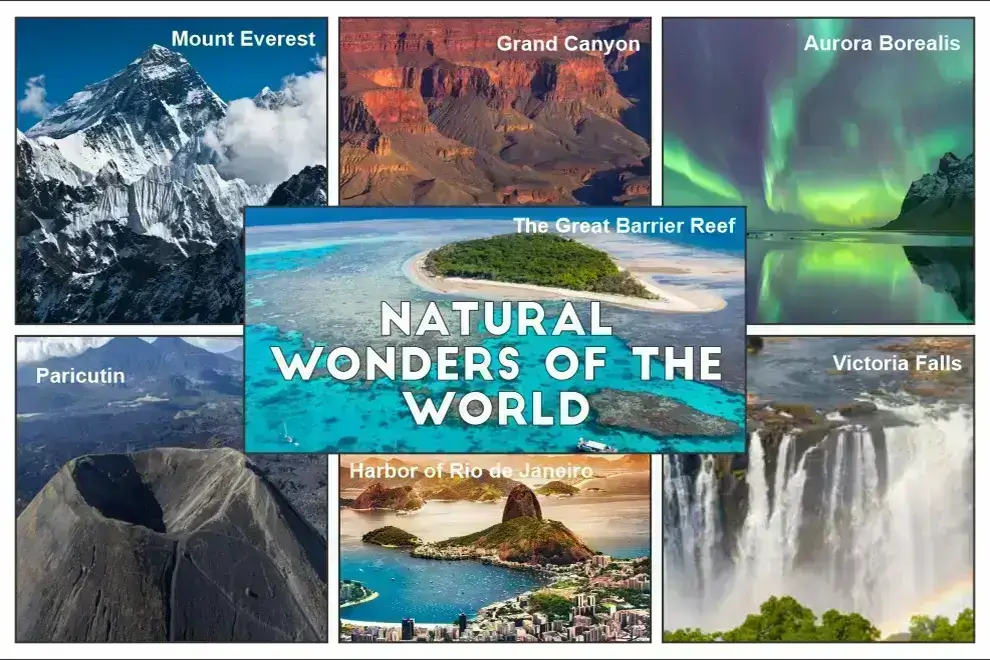Ever just stood somewhere–maybe a vast open space, near a powerful natural force, or just looking at something incredibly beautiful – and felt completely floored? Like, genuinely took your breath? Nature itself, over millions of years, shaped these unbelievable sights covering our planet. While you could list amazing places forever, there’s a specific set that always seems to capture everyone’s imagination: they’re called the Seven Natural Wonders of the World.
These aren’t buildings or anything humans built. Nope. These are Earth’s massive artworks, forged by pure geological muscle, changing weather, and life pushing through. These truly are the kind of sights that make you think about the Natural Wonders of the World.
Let’s take a quick trip and check out these incredible spots:
1. Mount Everest (Nepal/Tibet)

Okay, top billing goes to Everest. It just is the highest mountain peak anywhere on Earth, measured from sea level. Sitting there in the huge Himalayas, its snowy peak pushes up into the sky at a wild 8,848.86 meters (yeah, that’s almost 30,000 feet!). Reaching the top? That’s one of the absolute toughest challenges humans take on – battling extreme cold, hardly any air, and seriously dangerous climbs.
It’s way more than just a big hill; it’s like Earth showing off its power, and us trying to meet the challenge. Everest stands tall among the Natural Wonders of the World. For those dreaming of seeing it or trekking towards Base Camp, the spring (April-May) and fall (September-October) seasons generally offer the most stable, clearer weather windows, avoiding the harsh winter snows and summer monsoons.
2. Parícutin Volcano (Mexico)

Okay, this one’s wild because its whole existence, from popping up to going quiet, was seen by people! Back in 1943, a crack opened in a farmer’s cornfield in Michoacán, Mexico. Within a year, a whole volcano cone was standing over 336 meters tall. It kept going for about nine years, finally hitting 424 meters (1,391 feet). A truly unique story among the Natural Wonders of the World.
It’s inactive now, but that stark, ash-covered shape and the old church tower almost buried nearby are a crazy reminder of how fast and strong the Earth can sometimes change things. Visiting during the dry season, roughly from November to April, typically makes exploring the area around the volcano much easier and more comfortable than during the rainy season.
3. The Grand Canyon (USA)

Imagine water, just the Colorado River, working away for millions and millions of years. That’s how you get the Grand Canyon in Arizona. This giant cut goes on for 446 kilometers (that’s a good 277 miles!), can be nearly 30 kilometers wide (18 miles!), and drops down a crazy 1.6 kilometers (over a mile!). The sheer scale of this cut makes it a prime example of the Natural Wonders of the World.
Standing on the edge? It honestly makes you feel tiny. You look at those rock layers, and it’s like looking back through time at Earth’s whole story. The colours even change depending on the light. Seriously unforgettable. For exploring, spring and fall (March-May and September-November) are usually best, offering much milder temperatures than the scorching summer or potentially icy winter months.
4. The Aurora Borealis (Northern Lights)

Maybe the most like something from another world, the Aurora Borealis doesn’t sit in just one spot. It’s a sky show you see best in places way up north, near the Arctic Circle (there’s a southern version too). These lights? They just dance across the night sky, shimmering in green, pinks, blues, and purples. This celestial display is surely one of the most beautiful Natural Wonders of the World.
They happen when tiny charged bits from the sun hit our atmosphere’s atoms, guided by Earth’s magnetic field. Watching an aurora is just… people call it magical, like nothing else you’ve ever seen. Your best chance to witness this incredible display is during the dark, cold months, usually from late August or September through April, provided the sky is clear.
5. The Harbor of Rio de Janeiro (Brazil)

People often say this is one of the prettiest natural harbours anywhere, and it’s easy to see why. Guanabara Bay in Rio de Janeiro is just set up perfectly. It’s got these massive granite rocks all around it, including the instantly famous Sugarloaf Mountain and Corcovado Mountain, where the big Christ the Redeemer statue stands.
The way the bright blue water meets these distinct mountains, with the lively city, all fit together along the edges? It’s just a spectacular view. A definite highlight among the Natural Wonders of the World. While sunny most of the year, the shoulder seasons (April-May and September-October) often provide a great balance of pleasant weather and slightly fewer crowds compared to the peak summer months.
6. Victoria Falls (Zambia/Zimbabwe)

The local name is perfect: “Mosi-oa-Tunya.” It means “The Smoke that Thunders.” Victoria Falls, sitting on the Zambezi River right between Zambia and Zimbabwe, isn’t the tallest or widest single waterfall, but it drops the biggest sheet of water anywhere. The amount of water pounding down into that gorge below?
It creates this roar that’s deafening and sends mist shooting way up – you can see it from miles away! The power here is truly indicative of the Natural Wonders of the World. That mist keeps a unique little patch of rainforest alive right there. You can feel the power vibrating. If you want to see the sheer volume at its peak, visit between February and May, though the mist can be thick; for clearer views and activities like swimming in Devil’s Pool (seasonal), the drier months from June to October are better.
7. The Great Barrier Reef (Australia)

Picture this: you can even see it from space. The Great Barrier Reef isn’t just one piece; it’s the planet’s biggest, most tangled system of coral reefs ever. It stretches for over 2,300 kilometers along the coast of Queensland, Australia. Think of it as a super busy city, but underwater, totally packed with sea life – you name it, from tiny microscopic stuff right up to giant whales.
The crazy mix of colours and all the delicate shapes make it a real biological treasure. This vast reef system is undeniably one of the great Natural Wonders of the World. But, hey, it’s also facing huge problems thanks to climate change, a harsh reminder of how delicate even massive nature can be. While you can visit year-round, the dry season, roughly from May to October, is often considered ideal for diving and snorkeling thanks to better water clarity and more comfortable temperatures.
A Note on the List
Honestly, looking at these Seven Natural Wonders of the World – from the highest points to deep cuts, vibrant reefs to lights in the sky – it hits home just how varied and powerful our planet is. They make you feel small, make you want to explore, and make you think about how important it is to look after these priceless places for everyone down the road. Even if you never get to visit them all, knowing they exist just makes the world feel a bit richer, doesn’t it?
It’s worth mentioning that, unlike the historical Seven Wonders of the Ancient World, there isn’t just one single, universally agreed-upon official list of the “Seven Natural Wonders of the World.” The selection highlighted here represents one of the most commonly referenced and popular versions. Of course, our incredible planet boasts countless other truly breathtaking natural sites that inspire awe and deserve recognition!











